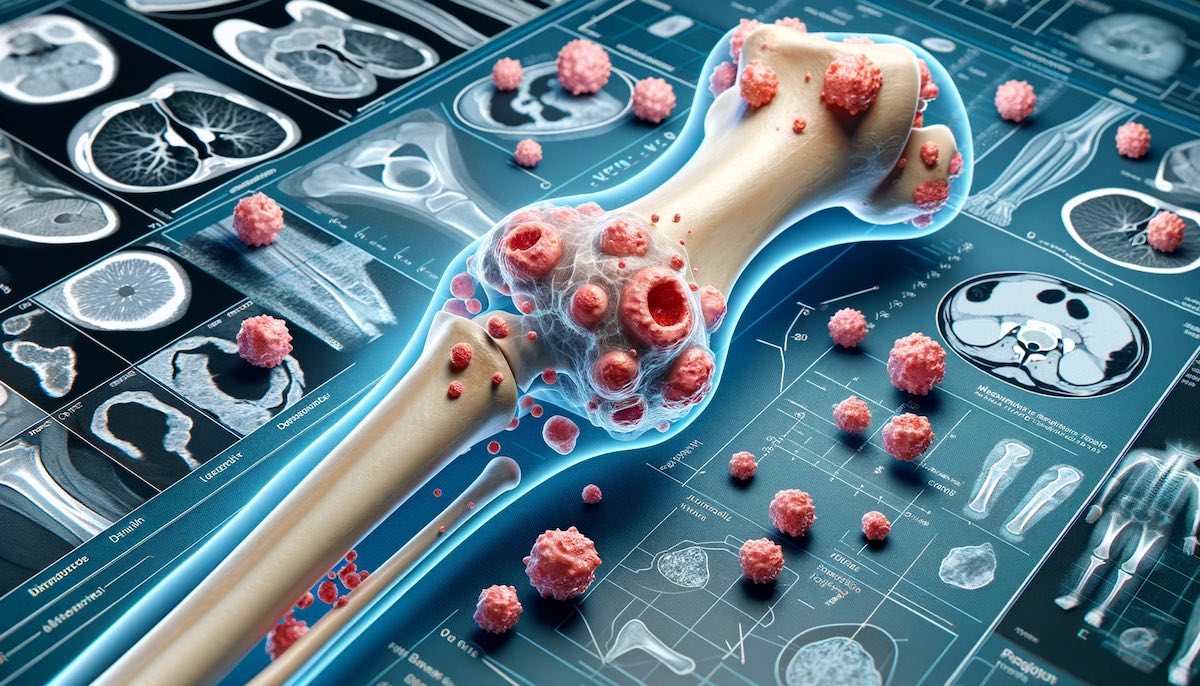Bone Sarcomas: Types, Symptoms and Treatment

Bone sarcomas, a critical subset of sarcomas, are rare cancers that originate in the bones. While they account for a small percentage of overall cancer diagnoses, their impact on patients and their families is significant. This article provides an in-depth look at bone sarcomas, their types, symptoms, diagnosis, and treatment options, aimed at fostering awareness and understanding of these rare conditions.
What are Bone Sarcomas?
Bone sarcomas are malignant tumors that form in the bone tissue. They can occur in any bone in the body but are most commonly found in the long bones of the arms and legs. Unlike other types of cancer that spread to the bones, bone sarcomas start in the bone itself, making their treatment and prognosis different.
Types of Bone Sarcomas
Bone sarcomas come in various forms, each with unique characteristics. The most common types include:
- Osteosarcoma:
- Predominantly affects children and young adults.
- Often develops in the bones around the knee and upper arm.
- Symptoms include pain and swelling in the affected area.
- Chondrosarcoma:
- Mainly occurs in adults.
- Develops in cartilage, usually in the pelvis, thigh bones, and shoulders.
- Symptoms can be pain and swelling, but it often grows slowly and may not show early symptoms.
- Ewing’s Sarcoma:
- Primarily affects children and teenagers.
- Typically arises in the pelvis, thigh, and lower leg bones.
- Symptoms include pain, swelling, and fever.
RELATED POSTS
Symptoms of Bone Sarcomas
While symptoms can vary depending on the type of bone sarcoma, common signs include:
- Persistent pain in the affected bone, often worsening at night.
- Swelling and tenderness near the affected area.
- Fractures that occur with minimal injury.
- Fatigue and weight loss.
Diagnosing Bone Sarcomas
Diagnosis of bone sarcomas involves several steps:
- Medical history and physical examination.
- Imaging tests like X-rays, CT scans, MRI, and bone scans.
- Biopsy to confirm the diagnosis.
Treatment Options
Treatment for bone sarcomas depends on the type, size, location, and stage of the cancer. Common treatment methods include:
- Surgery: The primary treatment method, often aiming to remove the tumor while preserving as much bone and limb function as possible.
- Chemotherapy: Used before and/or after surgery to shrink the tumor and kill any remaining cancer cells.
- Radiation therapy: Often used in conjunction with surgery, especially for Ewing’s sarcoma.
Get a Medical Opinion
Fill out the form and we will contact you shortly.
When it comes to treating bone sarcomas, surgery is often the primary treatment method. The goal is to remove the tumor while preserving as much of the bone and limb function as possible. However, the role of an experienced oncologist in the pre-surgical phase is crucial. Consulting with a specialized oncologist before surgery can significantly improve the success of the treatment. Oncologists can assess the specific nature and stage of the cancer, potentially recommending neoadjuvant therapy (treatment before surgery), such as chemotherapy or radiation, to shrink the tumor and make surgery more effective. This collaborative approach ensures a more tailored and potentially more successful treatment outcome.
The Importance of Expertise in Diagnosis and Treatment
When dealing with bone sarcomas, the expertise and experience of the healthcare team play a pivotal role in successful diagnosis and treatment. Bone sarcomas are complex and rare, requiring specialized knowledge for accurate identification and management. Experienced oncologists and orthopedic surgeons are essential in developing an effective treatment plan. They can interpret diagnostic tests accurately, understand the subtleties of different sarcoma types, and recommend the most appropriate treatment options. Furthermore, specialists in sarcomas are often more familiar with the latest research, treatment techniques, and clinical trials, offering patients access to cutting-edge therapies. Therefore, patients are advised to seek care from medical centers or hospitals that specialize in cancer treatment, particularly sarcomas, to ensure the best possible outcomes.
Global Access to Experienced Doctors and Advanced Medical Facilities
In today’s interconnected world, accessing experienced doctors and state-of-the-art medical facilities for treating bone sarcomas has become significantly more feasible, regardless of one’s geographic location. With the advent of global health tourism and advancements in telemedicine, patients now have the opportunity to seek the best possible care, even if it means traveling internationally. This global accessibility ensures that patients can reach specialists who have extensive experience with bone sarcomas, benefit from advanced diagnostic tools, and receive treatments that might not be available in their home country. Additionally, international collaboration among cancer specialists has improved treatment protocols and outcomes for bone sarcoma patients worldwide. This ease of access to global healthcare resources empowers patients to make informed decisions about their treatment and pursue the most effective care available.
Frequently Asked Questions About Bone Sarcomas
Bone sarcomas can occur at any age, but certain types are more common in specific age groups. For example, osteosarcoma is most common in teenagers and young adults, while chondrosarcoma typically affects adults over 40.
There are no sure ways to prevent bone sarcomas as the exact causes are often unknown. However, maintaining a healthy lifestyle and avoiding known cancer risk factors may reduce the overall risk of developing various types of cancer.
Early signs of bone sarcomas include persistent pain, swelling, or the presence of a lump in the bone area. Regular medical check-ups and attention to these symptoms can aid in early detection, although there are no specific screening methods for bone sarcomas.
The survival rate for bone sarcomas varies depending on the type, stage, and patient’s overall health. Advancements in treatment have significantly improved survival rates, especially when diagnosed early and treated by experienced medical professionals.
Post-treatment care is crucial for bone sarcoma patients. It includes regular follow-up appointments, physical therapy, and monitoring for any signs of recurrence. Ongoing support and rehabilitation play a vital role in the patient’s overall recovery and quality of life.
Conclusion
Bone sarcomas, though rare, require early detection and specialized care. Advances in treatment have significantly improved outcomes, particularly for children and young adults. If you suspect symptoms of bone sarcoma, it is crucial to seek prompt medical attention for an accurate diagnosis and treatment plan.
Contact Information
- WhatsApp: +90 541 469 11 94
- Email: [email protected]
We connect you with top medical specialists and provide comprehensive support to optimize your healthcare decisions. Empowering you to make informed choices for a healthier future.
Get a Medical Opinion
Fill out the form and we will contact you shortly.
